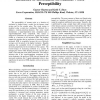Free Online Productivity Tools
i2Speak
i2Symbol
i2OCR
iTex2Img
iWeb2Print
iWeb2Shot
i2Type
iPdf2Split
iPdf2Merge
i2Bopomofo
i2Arabic
i2Style
i2Image
i2PDF
iLatex2Rtf
Sci2ools
PICS
2001
2001
Influence of Resolution on Scanner Noise Perceptibility
The perceptibility of scanner noise as a function of resolution is studied using a model for the human visual system and for the scanner noise. The visual system is modeled using a point-wise nonlinearity followed by a lightness contrast-sensitivity-function. The noise model incorporates a signal-dependent noise component and a signal-independent noise component. The system is analyzed to determine the perceived signal-to-noise ratio (SNR) as a function of the measured SNR. The findings support the intuition that as resolution is increased a lower measured SNR is acceptable because the eye effectively averages over the pixels at the higher resolution. Roughly speaking, the acceptable levels of measured SNR are inversely proportional to the resolution of the scanner. The overall impact of increasing resolution in a scanner by changing the sensor while keeping the lamp and the optics fixed is also analyzed in the same framework. The analysis indicates that if the signal-dependent compon...
| Added | 31 Oct 2010 |
| Updated | 31 Oct 2010 |
| Type | Conference |
| Year | 2001 |
| Where | PICS |
| Authors | Gaurav Sharma, Keith T. Knox |
Comments (0)

